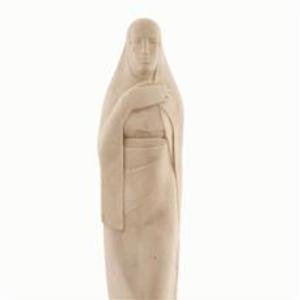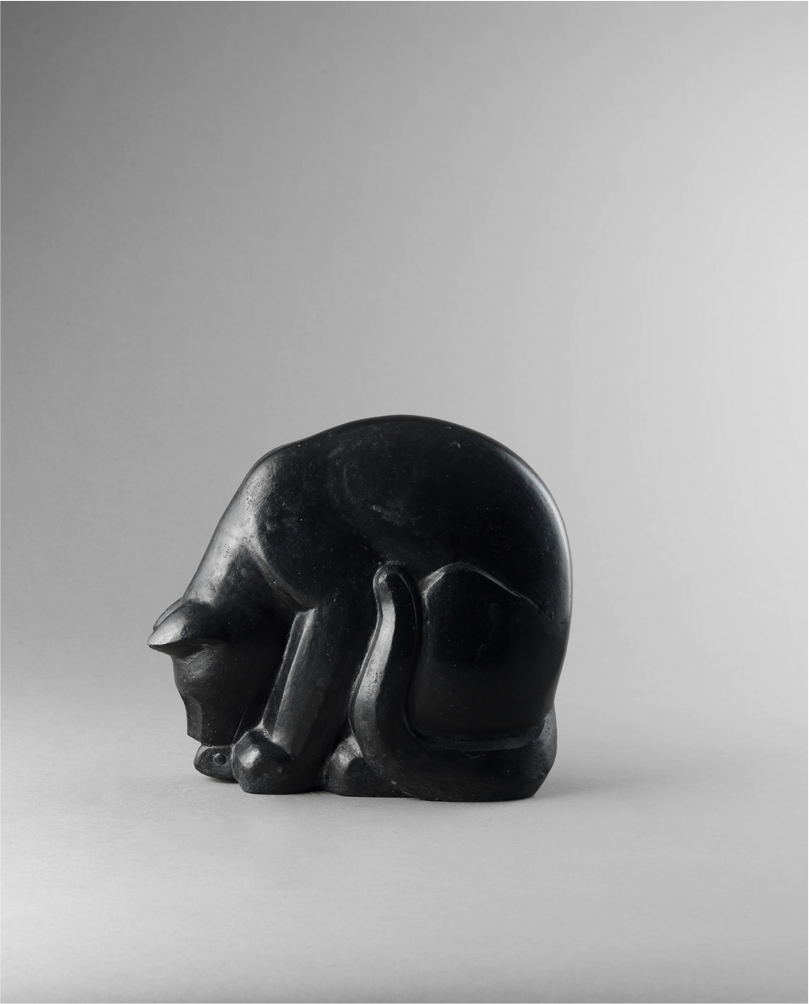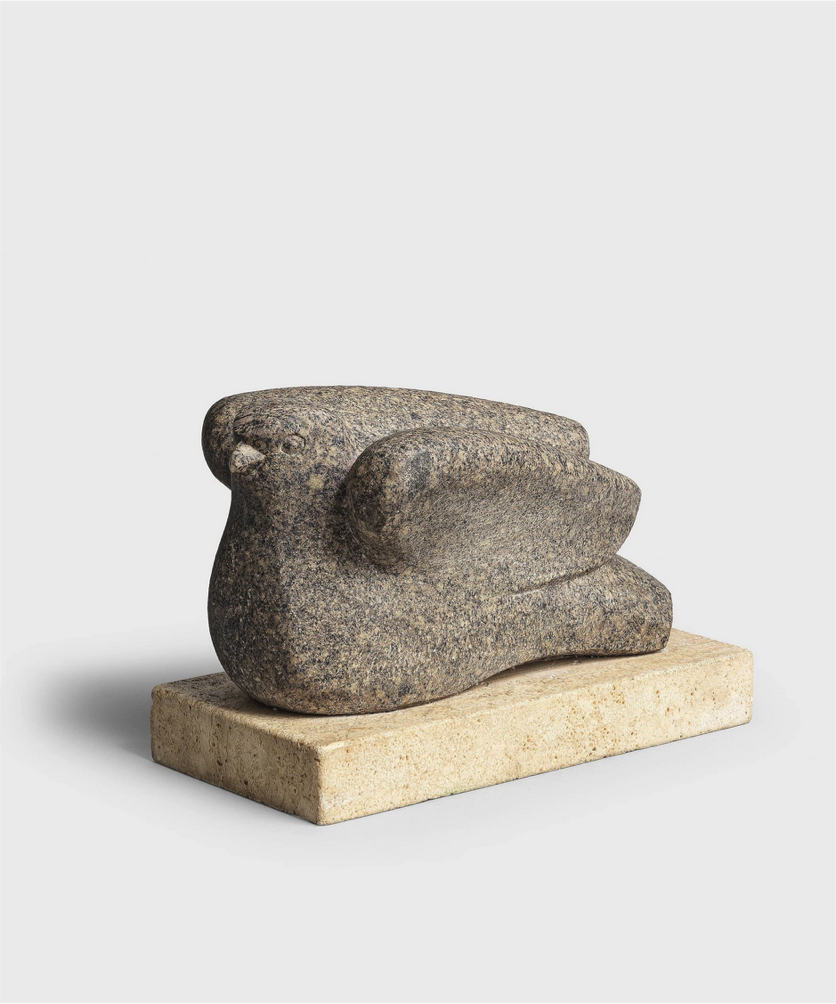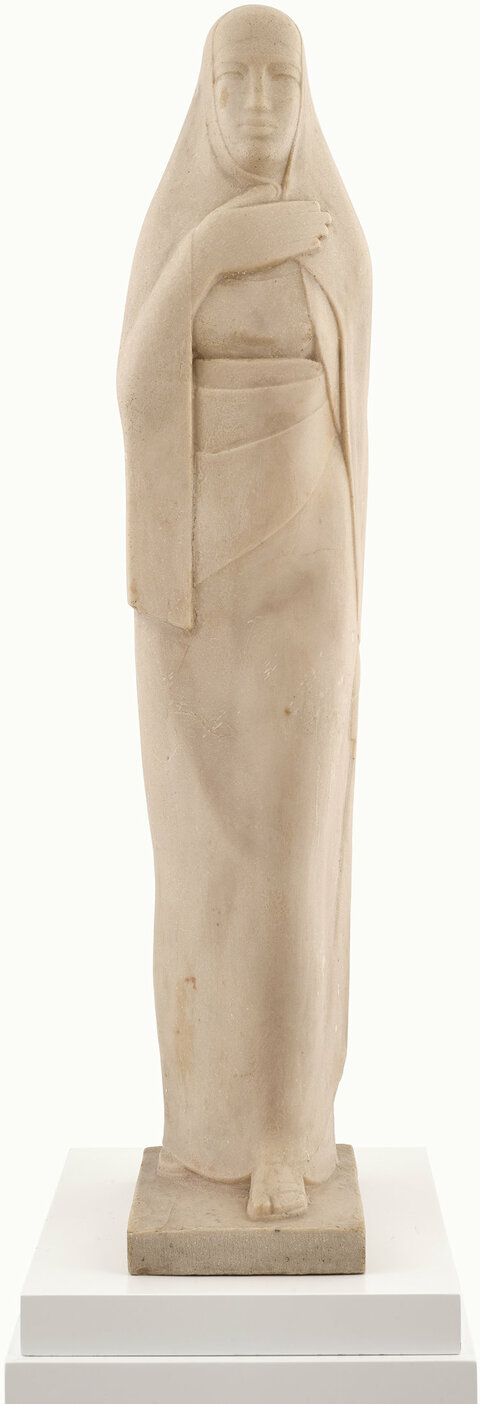Born in Alexandria, Egypt, in 1913, Mahmoud Moussa was a sculptor from the second generation of pioneers of Modern art in the country. With the intention of continuing his father’s profession,...


MAHMOUD MOUSSA, Egypt (1913 - 2003)
Bio
Written by MARIA LUNDERSKOV
Born in Alexandria, Egypt, in 1913, Mahmoud Moussa was a sculptor from the second generation of pioneers of Modern art in the country. With the intention of continuing his father’s profession, which involved the creation of stucco decorations for building facades and interiors[i], Moussa began attending evening art classes. He frequented those provided by the Amateurs Society, led by the Egyptian painter Mahmoud Said, in 1931. Later, Moussa trained under the supervision of the Egyptian sculptor Mahmoud Mokhtar (1891-1934). In 1957, Moussa earned a position as a teacher in the Department of Sculpture at the Faculty of Fine Arts in Alexandria[ii].
Moussa’s oeuvre drew inspiration from Ancient Egyptian art and aligned with the Neo-Pharaonic art movement[iii]. This kind of art involved the first generation of modern Egyptian artists merging Western artistic traditions – learned while studying in Europe – with elements from Ancient Egypt in order to rethink its aesthetic and form a new national style. Mahmoud Moukhtar, together with other artists like Mohamed Naghi (1888-1956) and Mahmoud Said (1897-1964), laid the groundwork for the Neo-Pharaonic aesthetic in the 1920s. In the constant search of the true representation of Egypt, they intermingled the iconography of Ancient Egypt with realist representations of contemporary rurality. The peasant became a pivotal subject in this search, since it was perceived as impermeable to change over time. It embodied the modern idea of connecting the past with the present[iv]. Using materials like granite, marble, and terracotta, Moussa executed pieces that were reminiscent of the sculptural practices of ancient times. He represented Egyptian peasants and animals venerated in Egyptian mythology.
Moussa, unlike many other modern artists, did not undergo formal artistic training in Europe. Nevertheless, the educational framework for art in Modern Egypt was predominantly shaped by European pedagogy and artistic traditions[v]. Consequently, the sculptures of women from his early years exhibit a discernible European influence. The depiction of nude female figures in reclining or sitting positions, such as in Untitled, 1946[vi], wherein the subject embraces her knees and rests her head upon them, evokes the life-drawing practices commonly conducted in European art studios. While these sculptures seem to be the result of anatomical studies and experimentation with European art styles, Moussa developed his own artistic voice through his representations of the Egyptian fellaha (peasant woman).
By intertwining Islamic symbolism into ancient sculptural techniques, Moussa created a distinctive portrayal of the fellaha that bridges earlier representations by the first generations of pioneers, with the aesthetic that emerged in the 1950s. The marble sculpture Egyptian Woman, 1990, presently housed within the Ramzi and Saeda Dalloul Art Foundation collection, represents one among several works crafted by Moussa dating back to the 1950s. The work depicts a veiled woman in a walking stance. The floor-length skirt, devoid of embellishments, drapes softly over her body, allowing the subtle movement of her hips and legs to be discerned. Her veil, framing her face, is held closed by her right hand placed upon her chest, cascading gently over her shoulders to cover both arms completely. The slightly oversized hand, lacking in detail such as defined nails or knuckles, is held flat with fingers closed. The austerity of the statue, expressed through its composed posture, fully covered body, and tightly held veil, may signify resistance against Western gender norms.
The reference to Islamic customs in Moussa´s work suggests an even stronger anti-colonial stance than that seen in earlier pioneers like Moukhtar and Said. Their depictions of the fellaha asserted national pride through an aesthetic initially propagated by Orientalists – an emphasized sensuality and strength of working women through rounded body lines, often resembling the shape of the water jars they carried[vii]. The emphasis on symbols like the veil (hijab or niqab) or the Islamic crescent are recurrent in Moussa's artistic repertoire. This was a popular trend during Gamal Abdel Nasser's rule (1956-1970)[viii], which marked a shift towards emphasizing Islamic heritage over the previously dominant fascination with Ancient Egyptian motifs characteristic of the Neo-Pharaonic style[ix].
Besides the study of the fellaha, Moussa also created sculptures representing cats, doves, and goats, contributing to the ancient Egyptian tradition of animal sculptures. Animal representation in Ancient Egypt was deeply connected to Egyptian mythology, where animals played pivotal roles. Thus, statues were a celebration of the qualities of an animal. For example, cats were prized as defenders against unwanted animals like rats, mice, and snakes[x], and were associated with animal gods according to mythology[xi]. In his sculptures, Moussa translates the symbolism of the ancient era into contemporary socio-political events, bridging the past with the present.
In the black marble statue The Cat and the Snake, 1978[xii], depicting a curled-up cat sitting on its hind legs, Moussa potentially uses the symbolism of the cat as defender to convey an anti-colonial sentiment. Similarly, the statue Dove, 1982[xiii], with its open wings carved from grey stone, might translate a sentiment of freedom in reference to Israel's withdrawal from the Sinai Peninsula after a 15-year occupation in 1982. The dove holds significance across various monotheistic religions as well as paganism, symbolizing life, purity, peace, and freedom. Thereby, this symbolic interpretation bridges the ancient to the contemporary era, becoming a global symbol. Consequently, Moussa’s artworks align with the ideology of Neo-Pharaonism, which seeks to reimagine the historical past and assert a universal culture through the ongoing interplay between modernity and national discourse[xiv].
Through his sculptures, Mahmoud Moussa engaged with ancient symbolism and contemporary socio-political contexts. He navigated the complexities of gender, nationalism, and cultural heritage, contributing to the ongoing discourse surrounding Egyptian identity in his time. Thus, his contributions epitomize a harmonious synthesis of tradition and innovation, leaving an indelible mark on Egypt's artistic legacy. The artist passed away in 2003, at the age of ninety.
Literature
Bonhams. “Mahmoud Moussa (Egypt, 1913-2003), the cat and the snake.” Accessed March 25, 2024. www.bonhams.com
Bonhams. “Mahmoud Moussa (Egypt, 1913-2003),The Worker.” Accessed March 25, 2024. www.bonhams.com
E.A.W. Budge, The Egyptian Book of the Dead. London, Penguin Classics, 2008, 380-8.
John F. Kennedy Presidential Library and Museum. “President Gamal Abdel-Nasser.” Accessed April 30, 2024. https://jfk.artifacts.archives.gov
Karnouk,Liliane. Modern Egyptian Art 1910-2003. Cairo: The American University in Cairo Press, 2005
Marie, Mustafa,.“Egypt’s Fine Arts Museum displays Mahmoud Moussa’s sculptures.” Egypt Today, April 08, 2020. www.egypttoday.com
Mills, Sara. “The Sacred Cats of Ancient Egypt,” DailyArt, August 8, 2023. www.dailyartmagazine.com
MutualArt. “Mahmoud Moussa, Dove,” MutualArt, Accessed March 26, 2024. www.mutualart.com/Artwork/Dove
MutualArt. “Mahmoud Moussa, Untitled.” Accessed April 2, 2024. www.mutualart.com
Radwan, Nadia. “Between Diana and Isis: Egypt’s “Renaissance” and the Neo-Pharaonic Style (1920s‒1930s).” In Dialogues artistiques avec les passés de l’Égypte. Paris: Publications de l’Institut national d’histoire de l’art, 2017.
Seggerman, Alex Dika. “Potent Flows: The Fellaha and Water Jug.” In Modernism on the Nile: Art in Egypt between the Islamic and the Contemporary. University of North Carolina Press, 2019.



Notes:
[i] Mustafa Marie, “Egypt's Fine Arts Museum displays Mahmoud Moussa’s sculptures,” Egypt Today, April 08, 2020, www.egypttoday.com
[ii] “Mahmoud Moussa (Egypt, 1913-2003),The Worker,” Bonhams, accessed March 25, 2024 www.bonhams.com
[iii] “Mahmoud Moussa (Egypt, 1913-2003),The Worker,” Bonhams, accessed March 25, 2024 www.bonhams.com/auction
[iv] Nadia Radwan, “Between Diana and Isis: Egypt’s “Renaissance” and the Neo-Pharaonic Style (1920s‒1930s),” in Dialogues artistiques avec les passés de l’Égypte (Paris: Publications de l’Institut national d’histoire de l’art, 2017)
[v] Liliane Karnouk, Modern Egyptian Art 1910-2003 (Cairo: The American University in Cairo Press, 2005), 78-79
[vi] “Mahmoud Moussa, Untitled,” MutualArt, Accessed April 2, 2024, www.mutualart.com
[vii] Alex Dika Seggerman, “Potent Flows: The Fellaha and Water Jug,” in Modernism on the Nile: Art in Egypt between the Islamic and the Contemporary (University of North Carolina Press, 2019)
[viii] “President Gamal Abdel-Nasser,” John F. Kennedy Presidential Library and Museum, accessed April 30, 2024, https://jfk.artifacts.archives.gov
[ix] Nadia Radwan, “Between Diana and Isis: Egypt’s “Renaissance” and the Neo-Pharaonic Style (1920s‒1930s),” in Dialogues artistiques avec les passés de l’Égypte (Paris: Publications de l’Institut national d’histoire de l’art, 2017)
[x] Sara Mills, “The Sacred Cats of Ancient Egypt,” DailyArt, August 8, 2023, www.dailyartmagazine.com
[xi] See E.A.W. Budge, The Egyptian Book of the Dead (London, Penguin Classics, 2008)
[xii] “Mahmoud Moussa (Egypt, 1913-2003), the cat and the snake,” Bonhams, accessed March 25, 2024, www.bonhams.com
[xiii] “Mahmoud Moussa, Dove,” MutualArt, Accessed March 26, 2024, www.mutualart.com
[xiv] Nadia Radwan, “Between Diana and Isis: Egypt’s “Renaissance” and the Neo-Pharaonic Style (1920s‒1930s),” in Dialogues artistiques avec les passés de l’Égypte (Paris: Publications de l’Institut national d’histoire de l’art, 2017)
CV
Selected Solo Exhibitions
2024
Mahmoud Moussa: Retrospective Exhibition, Motion Art Gallery, Zamalek, Egypt
1987
The Egyptian Academy, Rome, Italy
1974
Mahmoud Moussa: Collective Work – with artist Esmat Dawestashy, The Soviet Cultural Center, Alexandria, Egypt
1973
Mahmoud Moussa: Collective Work – with artist Salam Eid, The Soviet Cultural Center, Alexandria, Egypt
Selected group Exhibitions
2023
Crossroads: A Collector’s Tale, The Joumana Mourad & Rabie Besiso’s private collection, Picasso Art Gallery, Cairo, Egypt
2020
Online Exhibition, The Museum of Fine Arts, Alexandria, Egypt
2017
One Hundred Years Closer to Communism: Art and Revolution in the Middle East, AUB Art Galleries and Collections, American University of Beirut (AUB), Beirut, Lebanon
2007
Khan Al Maghraby Art Gallery, Zamalek, Egypt
Awards
1963
The Egyptian Section 1st Prize, Alexandria Biennale, Alexandria, Egypt
1995
The 1st Prize for Sculpture, Alexandria Biennale, Alexandria, Egypt
Collections
Ramzi and Saeda Dalloul Art Foundation (DAF), Beirut, Lebanon
Dubai Collections, Dubai, United Arab Emirates
Arab Museum of Modern Art – Mathaf, Doha, Qatar
The museum of Modern Egyptian Art, Cairo, Egypt
Alexandria Museum of Fine Arts, Alexandria, Egypt
Press
Middle East anti-fake drive triggers refund The Art Newspaper.pdf
Ahram Online - Heritage and modernity_ _Aswany_ at Tache Art.pdf
البوابة نيوز_ عصمت داوستاشي يرصد حياة النحات محمود موسى في كتاب جديد.pdf
محمود موسى.. يتحدى الصخر.pdf
مصرس _ محمود موسي من حرفي للزخارف الجصية إلي أستاذ في الفنون.pdf
الفنان محمود موسى_ الفن التشكيلي ألهمني صناعة العود.pdf
متحف في بيتك.. أعمال الفنان محمود موسي بـ_فنون جميلة الإسكندرية_.pdf
متحف فى بيتك.. شاهد أعمال محمود مرسى ضمن مقتنيات متحف الفنون الجميلة - اليوم السابع.pdf
MAHMOUD MOUSSA Artwork
Become a Member
Join us in our endless discovery of modern and contemporary Arab art
Become a Member
Get updates from DAF
Follow Artists
Save your favourite Artworks
Share your perspectives on Artworks
Be part of our community
It's Free!
We value your privacy
TermsCookiesPrivacy Policies
Become a Member
Get updates from DAF
Follow Artists
Save your favourite Artworks
Share your perspectives on Artworks
Be part of our community
It's Free!
We value your privacy
TermsCookiesPrivacy Policies
Become a Member
Get updates from DAF
Follow Artists
Save your favourite Artworks
Share your perspectives on Artworks
Be part of our community
It's Free!
We value your privacy
TermsCookiesPrivacy Policies
Welcome to the Dalloul Art Foundation
Thank you for joining our community
If you have entered your email to become a member of the Dalloul Art Foundation, please click the button below to confirm your email and agree to our Terms, Cookie & Privacy policies.
We value your privacy, see how
Become a Member
Get updates from DAF
Follow Artists
Save your favourite Artworks
Share your perspectives on Artworks
Be part of our community
It's Free!
We value your privacy
TermsCookiesPrivacy Policies




